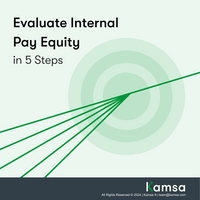
5 Steps to Evaluate Internal Pay Equity
If companies aren’t able to offer a compelling compensation package, employees' eyes will wander. Companies need to not only offer fair pay that is competitive to the market but also equitable internally amongst current employees (i.e., internal pay equity).
To cultivate fair pay internally, companies need a compensation structure in place that allows them to easily assess whether employees in similar roles (in jobs with comparable skills and experience) are compensated equitably.
Having internally fair pay not only keeps employees from being distracted and staying productive but strengthens your employer brand.
Evaluating and Closing Pay Gaps
So, how do you assess your internal pay equity within an organization?
Here's a simple 5-step approach to achieving pay equity:
-
Standardized Job Levels
As a first step, make sure the organization has a consistent job leveling framework.
The job levels should be defined based on factors like level of responsibility (e.g., accountability and scope), organization impact, and required experience, knowledge, and skills. Having a standardized job levels structure in place allows you to more seamlessly compare apples to apples and evaluate employees’ pay.
Pro tip: Use these levels consistently as you hire and consider promoting employees.
-
Measure Pay Gaps
Once a scalable job level structure is established, calculate each employee's compa-ratio.
To calculate the employee’s compa-ratio, divide their actual salary by the market midpoint for their role (aligned with their job level, work location, and the target market percentile per the company’s compensation philosophy).
A compa-ratio of 100% means an employee is paid right at the market. A healthy compa-ratio is considered 85% to 115% in most countries.
-
Identify Pay Gaps
After you have calculated each employee’s compa-ratio, you’re ready to group employees by their job family (e.g., Software Engineers vs. Account Executives, etc.), and job level (e.g., IC3, IC4, Manager, Senior Manager, etc.).
This allows you to analyze compa-ratios within specific departments, teams, and roles and provides a more detailed view of potential pay discrepancies between various demographic categories (e.g., gender, race/ethnicity).
-
Address Pay Gaps
To identify any pay gaps, compare the average compa-ratio within each grouping. Significant deviations from the average compa-ratios between each grouping category (e.g., higher than 5% difference) may indicate areas to focus on to address.
For example, if the average compa-ratio for male Senior Software Engineers is more than 5% difference between the average compa-ratio for female Senior Software Engineers.
Pro Tip: Double check that the employees whose compa-ratio have significant variance to the average compa-ratio for their grouping are job leveled accurately.
-
Close Pay Gaps
For the pay gaps you have identified, document the reasons. For example, maybe the gap is due to a recent job level correction, or maybe the employee is very ‘green,’ or an underperformer.
Next is the ‘don’t talk about it, be about it’ part: Develop a plan for closing the divide through salary adjustments and decide on the timing of it (i.e., the next upcoming compensation review cycle).
Calculate the estimated costs to close the gaps and collaborate with Finance to ensure a budget is set aside to get any employees' salaries up to par.
Pro Tip: Establish a communication review plan and ensure you tie in performance, whenever possible.
Prevent Pay Gaps in the Future
Now that you've taken steps to address any current pay gaps, how do you prevent them from happening again?
Leverage market compensation data from reliable sources like Kamsa that is not lagging to ensure new hires are paid market-competitive salaries while balancing internal equity (i.e., factor in the internal average for their role and location when making offers). Kamsa helps manage compensation reviews efficiently and allows managers to make data-driven pay decisions.
Continuous Monitoring to Maintain Pay Fairness
Internal pay equity is an ongoing process. Regularly review and analyze your employees’ job levels and compa-ratios to ensure pay is fair, consistently. By prioritizing internal pay equity, your company can build a culture of fairness and transparency, and as a result, have employees who are more focused on contributing to the growth of the company versus being distracted by their pay.
About Kamsa
Kamsa believes in making it simple to help companies pay employees fairly. Kamsa uses machine learning for job leveling and job matching to automate identifying pay gaps. Through Kamsa’s hybrid approach to compensation (technology + compensation experts), we help companies set a scalable foundation for compensation programs and get ahead of pay gaps.


